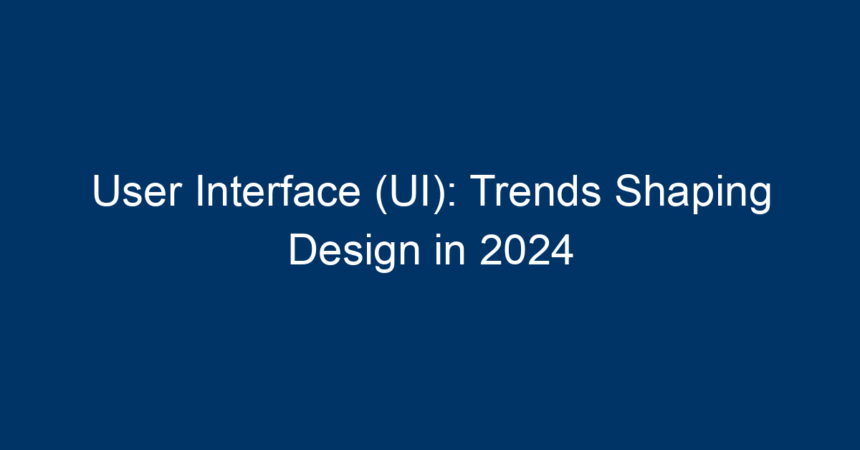In the rapidly evolving digital landscape, the significance of a well-designed user interface (UI) has never been greater. As technology advances and user expectations evolve, UI design trends shift accordingly, shaping how users interact with devices and applications. This article delves into the most impactful user interface (UI) trends that are set to define 2024, offering valuable insights for designers, developers, and businesses.
The Rising Importance of User-Centric Design
Understanding User Needs
In 2024, the priority is clear: user-centric design is paramount. As consumers become more discerning, understanding user needs and behavior will guide UI design. This trend emphasizes the importance of empathy maps and user personas, which help designers create interfaces tailored to specific audiences.
Personalized Experiences
Personalization is not just a feature; it’s a necessity. Users seek interfaces that speak directly to their preferences, habits, and needs. By leveraging data analytics and machine learning, designers can develop more dynamic and adaptive UIs that provide personalized content and functionalities, enhancing overall user satisfaction.
Dark Mode and Beyond: Visual Aesthetics in Focus
The Dominance of Dark Mode
The dark mode trend continues to flourish into 2024, driven by its aesthetic appeal and ergonomic benefits. Users appreciate the reduced eye strain during low-light conditions while also enjoying the sleek appearance it provides. Designers are now tasked with creating visually captivating dark themes that maintain readability and accessibility.
Vibrant Gradients and Dynamic Colors
While dark modes are in vogue, vibrant gradients are making a statement on the other end of the spectrum. Bright, lively color schemes, particularly in gradients, offer depth and dimension to UI designs. These vibrant hues not only make interfaces more engaging but also reflect a brand’s personality and ethos.
The Rise of Microinteractions
Enhancing User Engagement
Microinteractions are small animations or design elements that occur in response to user actions (like a button press or notification). These elements, often unnoticed by users, can significantly enhance engagement by providing feedback and guidance. In 2024, expect to see more sophisticated micro-interactions that not only delight users but also improve usability.
Streamlined Experiences Through Minimalism
Minimalism remains a strong trend, but it is evolving. In 2024, designers are focusing on creating streamlined experiences that eliminate distractions without sacrificing functionality. This balance of simplicity and utility is crucial for effective user interfaces (UI) that guide users effortlessly through their tasks.
Voice User Interface (VUI): A New Frontier
The Growing Popularity of Voice Commands
As smart devices increasingly incorporate voice recognition, VUI is becoming a pivotal aspect of UI design. In 2024, expect a surge in applications and websites that seamlessly integrate voice commands as primary interaction methods. Designers will need to consider how these interactions fit within the broader user experience, focusing on clarity and ease of use.
Creating Conversational Interfaces
With advancements in natural language processing (NLP), creating conversational interfaces will be key. Users will demand interfaces that feel intuitive and human-like. This presents UI designers with the challenge of crafting dialogue flows that guide users naturally, ensuring users can navigate effortlessly through voice interactions.
Augmented Reality (AR) and Virtual Reality (VR)
Immersive User Experiences
Emerging technologies like AR and VR are redefining user experiences in innovative ways. In 2024, incorporating AR in user interfaces can transform traditional interactions into immersive experiences. Consider how brands might use AR to allow users to visualize products in their own environment before purchasing—this shift can drastically improve engagement and satisfaction.
Crafting Intuitive Interactions in 3D Spaces
Designing UIs in 3D environments presents unique challenges. In 2024, designers must learn to create intuitive controls and navigation systems for these spaces. Understanding spatial awareness and user movement within AR and VR environments will be crucial for delivering seamless and engaging experiences.
Sustainable Design Practices
Emphasizing Eco-Friendly UI
As sustainability becomes a focal point for consumers, user interface (UI) design must adapt. In 2024, expect to see a rise in eco-friendly design practices, encouraging users to engage with sustainable products or services. Sustainable UI can involve using energy-efficient color palettes, optimizing load times to reduce server energy consumption, and promoting transparency around carbon footprints.
Designing for Longevity
Another aspect of sustainable design is the longevity of user interfaces (UI). More designers are prioritizing evergreen designs that resist the pressure of fleeting trends, thus encouraging longer product lifecycles. This not only benefits the environment but also fosters brand loyalty.
Accessibility: A Key Focus
Designing for Inclusivity
Accessibility in user interface design is not merely a checkbox; it is a fundamental necessity. As focus shifts to inclusivity, 2024 will see designers implementing best practices to ensure that users of all abilities can interact with their interfaces. Techniques include using adequate color contrast, alt text for images, and keyboard navigation compatibility.
Legal and Ethical Considerations
With increasing regulations around digital accessibility, user interface (UI) designers must be well-versed in legal compliance. Understanding accessibility standards such as WCAG (Web Content Accessibility Guidelines) will be essential in creating inclusive designs while protecting businesses from potential legal repercussions.
Actionable Insights for UI Designers
Stay Updated on Trends
Designers should continuously educate themselves on emerging trends, tools, and technologies. Joining industry communities and attending conferences can provide fresh perspectives and innovative ideas.
Prioritize User Testing
Regular testing with real users can uncover pain points and areas for improvement. Implement user feedback loops to refine and enhance your designs continuously.
Embrace Collaboration
UI design is most effective when it involves a multidisciplinary approach. Collaborate with developers, marketers, and UX designers to create comprehensive user experiences.
Adopt an Agile Mindset
In a fast-paced digital world, being adaptable is crucial. Embrace agile methodologies to iterate quickly and respond to changing user needs effectively.
Conclusion
The user interface (UI) landscape in 2024 is poised for exciting advances that prioritize user experiences, inclusivity, and innovative technologies. By staying informed about the latest trends, integrating user feedback, and embracing a user-centric approach, designers can create compelling interfaces that captivate users and drive brand loyalty. As we navigate this era of unprecedented change, those who adapt to and harness these trends will lead the way in effective, engaging, and meaningful design.
In summary, the trends shaping user interface (UI) design in 2024 are not just about aesthetics, but about creating deeper connections between users and technology. Embrace these insights, and ensure your UI designs are prepared for a vibrant, user-oriented future.




